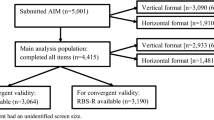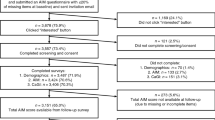Abstract
The current study describes the development and psychometric properties of a new measure targeting sensitivity to change of core autism spectrum disorder (ASD) symptoms, the Autism Impact Measure (AIM). The AIM uses a 2-week recall period with items rated on two corresponding 5-point scales (frequency and impact). Psychometric properties were examined using a large sample (n = 440) of children with ASD enrolled in the Autism Treatment Network. The exploratory factor analysis indicated four factors and resulted in a 25-item questionnaire with excellent overall model fit. Test–retest reliability, cross-informant reliability, and convergent validity with other measures of ASD symptoms and overall functioning were strong. The AIM is a reliable and valid measure of frequency and impact of core ASD symptoms.
Similar content being viewed by others
References
Accardo, P. J. (1999). Zebras in the living room: The changing face of autism. Journal of Pediatrics, 135(5), 533–535.
Aman, M. G., Novotny, S., Samango-Sprouse, C., Lecavalier, L., Leonard, E., Gadow, K. D., King, B., Pearson, D., Gernsbacher, M., & Chez, M. (2004). Outcome measures for clinical drug trials in autism. CNS Spectrums, 9(1), 36–47.
American Psychiatric Association. (2000). Diagnostic and statistical manual of mental disorders, 4th edition, text revision (DSM-IV-TR). Washington, DC: American Psychiatric Publishing.
Barthelemy, C., Roux, S., Adrien, J. L., Hameury, L., Guerin, P., Garreau, B., et al. (1997). Validation of the revised behavior Summarized Evaluation Scale. Journal of Autism and Developmental Disorders, 27(2), 139–153.
Bayley, N. (2006). Bayley scales of infant and toddler development. San Antonio: Harcourt Assessment Psych Corp.
Berument, S. K., Rutter, M., Lord, C., Pickles, A., & Bailey, A. (1999). Autism screening questionnaire: Diagnostic validity. British Journal of Psychiatry, 175, 444–451.
Bird, H. R., Andrews, H., Schwab-Stone, M., Goodman, S., Dulcan, M., Richters, J., et al. (1996). Global measures of impairment for epidemiologic and clinical use with children and adolescents. International Journal of Methods In Psychiatric Research, 6, 295–307.
Bruininks, R. H., Woodcock, R. W., Weatherman, R. F., & Hill, B. K. (1996). Scales of Independent Behavior (revised manual ed.). Boston, MA: Riverside Publishing Company.
Canino, G., Costello, E. J., & Angold, A. (1999). Assessing functional impairment and social adaptation for child mental health services research: A review of measures. Mental Health Services Research, 1(2), 93–108.
Centers for Disease Control. (2012). Prevalence of autism spectrum disorders: Autism and developmental disabilities monitoring network, 14 sites, United States, 2008. MMWR, 61(SS03), 1–19.
Charman, T., Howlin, P., Berry, B., & Prince, E. (2004). Measuring developmental progress of children with autism spectrum disorder on school entry using parent report. Autism, 8(1), 89–100.
Cohen, I. L., Schmidt-Lackner, S., Romanczyk, R., & Sudhalter, V. (2003). The PDD Behavior Inventory: A rating scale for assessing response to intervention in children with pervasive developmental disorder. Journal of Autism and Developmental Disorders, 33(1), 31–45.
Constantino, J. N., Davis, S. A., Todd, R. D., Schindler, M. K., Gross, M. M., Brophy, S. L., et al. (2003a). Validation of a brief quantitative measure of autistic traits: Comparison of the social responsiveness scale with the autism diagnostic interview-revised. Journal of Autism and Developmental Disorders, 33(4), 427–433.
Constantino, J. N., Gruber, C. P., Davis, S., Hayes, S., Passanante, N., & Przybeck, T. (2004). The factor structure of autistic traits. Journal of Child Psychology and Psychiatry, 45(4), 719–726.
Constantino, J. N., Hudziak, J. J., & Todd, R. D. (2003b). Deficits in reciprocal social behavior in male twins: Evidence for a genetically independent domain of psychopathology. Journal of the American Academy of Child and Adolescent Psychiatry, 42(4), 458–467.
Constantino, J. N., Przybeck, T., Friesen, D., & Todd, R. D. (2000). Reciprocal social behavior in children with and without pervasive developmental disorders. Journal of Developmental and Behavioral Pediatrics, 21(1), 2–11.
Cox, E. P. (1980). The optimal number of response alternatives for a scale: A review. Journal of Marketing Research, 17(4), 407–422.
DiLalla, D. L., & Rogers, S. J. (1994). Domains of the Childhood Autism Rating Scale: Relevance for diagnosis and treatment. Journal of Autism and Developmental Disorders, 24(2), 115–128.
Elliot, C. (2007). Differential Abilities Scale: 2nd Edition (DAS-II) Manual. San Antonio, TX: Harcourt Assessment, Inc.
Fombonne, E. (2005). The changing epidemiology of autism. Journal of Applied Research in Intellectual Disabilities, 18(4), 281–294.
Frazier, T. W., Youngstrom, E. A., Speer, L., Embacher, R., Law, P., Constantino, J., et al. (2012). Validation of proposed DSM-5 criteria for autism spectrum disorder. Journal of the American Academy of Child and Adolescent Psychiatry, 51(1), 28–40.
Freeman, B. J., Ritvo, E. R., Yokota, A., & Ritvo, A. (1986). A scale for rating symptoms of patients with the syndrome of autism in real life settings. Journal of the American Academy of Child and Adolescent Psychiatry, 25(1), 130–136.
Georgiades, S., Szatmari, P., Zwaigenbaum, L., Duku, E., Bryson, S., Roberts, W., et al. (2007). Structure of the autism symptom phenotype: A proposed multidimensional model. Journal of the American Academy of Child and Adolescent Psychiatry, 46(2), 188–196.
Gilliam, J. E. (1995). Gilliam Autism Rating Scale. Austin, TX: Pro-Ed.
Happe, F., & Ronald, A. (2008). The ‘fractionable autism triad’: A review of evidence from behavioural, genetic, cognitive and neural research. Neuropsychology Review, 18(4), 287–304.
Kanne, S. M., Gerber, A. J., Quirmbach, L. M., Sparrow, S., Cicchetti, D. V., & Saulnier, C. (2011). The role of adaptive behavior in autism spectrum disorders: Implications for functional outcome. Journal of Autism and Developmental Disorders, 41(8), 1007–1018.
Klin, A., Saulnier, C. A., Sparrow, S. S., Cicchetti, D. V., Volkmar, F. R., & Lord, C. (2007). Social and communication abilities and disabilities in higher functioning individuals with autism spectrum disorders: The Vineland and the ADOS. Journal of Autism and Developmental Disorders, 37(4), 748–759.
Lecavalier, L. (2005). An evaluation of the Gilliam Autism Rating Scale. Journal of Autism and Developmental Disorders, 35(6), 795–805.
Lord, C., Rutter, M., DiLavore, P. C., & Risi, S. (2002). Autism diagnostic observation schedule. Los Angeles, CA: Western Psychological Services.
Lord, C., Rutter, M., & Le Couteur, A. (1994). Autism Diagnostic Interview–Revised: A revised version of a diagnostic interview for caregivers of individuals with possible pervasive developmental disorders. Journal of Autism and Developmental Disorders, 24(5), 659–685.
Lozano, L. M., Garcia-Cueto, E., & Muniz, J. (2008). Effect of the number of response categories on the reliability and validity of rating scales. Methodology: European Journal of Research Methods for the Behavioral and Social Sciences, 4(2), 73–79.
Magiati, I., Moss, J., Yatges, R., Charman, T., & Howlin, P. (2011). Is the Autism Treatment Evaluation Checklist a useful tool for monitoring progress in children with autism spectrum disorders? Journal of Intellectual Disability Research, 55(3), 302–312.
Mandy, W. P., Charman, T., & Skuse, D. H. (2012). Testing the construct validity of proposed criteria for DSM-5 autism spectrum disorder. Journal of the American Academy of Child and Adolescent Psychiatry, 51(1), 41–50.
Mandy, W. P., & Skuse, D. H. (2008). Research review: What is the association between the social-communication element of autism and repetitive interests, behaviours and activities? Journal of Child Psychology and Psychiatry, 49(8), 795–808.
Matson, J. L. (2007). Determining treatment outcome in early intervention programs for autism spectrum disorders: A critical analysis of measurement issues in learning based interventions. Research in Developmental Disabilities, 28(2), 207–218.
McPheeters, M. L., Warren, Z., Sathe, N., Bruzek, J. L., Krishnaswami, S., Jerome, R. N., & Veenstra-VanderWeele, J. (2011). A systematic review of medical treatments for children with autism spectrum disorders. Pediatrics, 127(5), e1312–e1321.
Mullen, E. M. (1995). Mullen scales of early learning. Circle Pines, MN: American Guidance Service, Inc.
Muthén, L. K., & Muthén, B. O. (2010). Mplus user’s guide (6th ed.). Los Angeles, CA: Muthén & Muthén.
Preston, C. C., & Colman, A. M. (2000). Optimal number of response categories in rating scales: Reliability, validity, discriminating power, and respondent preferences. Acta Psychologica, 104(1), 1–15.
Rimland, B., & Edelson, S.M. (1999). Autism treatment evaluation checklist (ATEC). www.autism.com/ari.
Roid, G. H. (2003). Stanford-Binet intelligence scale manual (5th ed.). Itasca, IL: Riverside.
Roid, G. H., & Miller, L. (1997). Leiter international test of intelligence—revised. Chicago: Stoelting.
Rutter, M., Bailey, A., Berument, S. K., Le Couteur, A., & Lord, C. (2003). Social communication questionnaire (SCQ) manual. Los Angeles: Western Psychological Services.
Schopler, E., Reichler, R. J., DeVellis, R. F., & Daly, K. (1980). Toward objective classification of childhood autism: Childhood Autism Rating Scale (CARS). Journal of Autism and Developmental Disorders, 10(1), 91–103.
Shaffer, D., Gould, M. S., Brasic, J., Ambrosini, P., Fisher, P., Bird, H., et al. (1983). A children’s global assessment scale (CGAS). Archives of General Psychiatry, 40(11), 1228–1231.
Sparrow, S. S., Cicchetti, D., & Balla, D. A. (2005). Vineland Adaptive Behavior Scales—2nd Edition manual. Minneapolis, MN: NCS Pearson, Inc.
Stella, J., Mundy, P., & Tuchman, R. (1999). Social and nonsocial factors in the Childhood Autism Rating Scale. Journal of Autism and Developmental Disorders, 29(4), 307–317.
Tadevosyan-Leyfer, O., Dowd, M., Mankoski, R., Winklosky, B., Putnam, S., McGrath, L., et al. (2003). A principal components analysis of the Autism Diagnostic Interview-Revised. Journal of the American Academy of Child and Adolescent Psychiatry, 42(7), 864–872.
van Lang, N. D., Boomsma, A., Sytema, S., de Bildt, A. A., Kraijer, D. W., Ketelaars, C., et al. (2006). Structural equation analysis of a hypothesised symptom model in the autism spectrum. Journal of Child Psychology and Psychiatry, 47(1), 37–44.
Warren, Z., McPheeters, M. L., Sathe, N., Foss-Feig, J. H., Glasser, A., & Veenstra-Vanderweele, J. (2011a). A systematic review of early intensive intervention for autism spectrum disorders. Pediatrics, 127(5), e1303–e1311.
Warren, Z., Veenstra-Vanderweele, J., Stone, W. L., Bruzek, J. L., Nahmias, A. S., Foss-Feig, J. H., Jerome, R., Krishnaswami, S., Sathe, N., Glasser, A., Surawicz, T., & McPheeters, M. (2011b). Therapies for children with autism spectrum disorders. Comparative effectiveness review (Prepared by the Vanderbilt Evidence-based Practice Center No. 290-02-HHSA 290 2007 10065 I). AHRQ Publication Rockville, MD: Agency for Healthcare Research and Quality.
Wechsler, D. (1999). The Wechsler Abbreviated Scale of intelligence. San Antonio, TX: The Psychological Corporation.
Wechsler, D. (2002). WPPSI-III: Wechsler preschool and primary scale of intelligence (3rd ed.). San Antonio, TX: Psychological Corporation.
Wechsler, D. (2003). Wechsler Intelligence Scale for children (4th ed.). San Antonio, TX: Psychological Corporation.
Weng, L. J. (2004). Impact of the number of response categories and anchor labels on coefficient alpha and test–retest reliability. Educational and Psychological Measurement, 64(6), 956–972.
Acknowledgments
The authors acknowledge the members of the Autism Speaks Autism Treatment Network (AS ATN) for use of the data. The data for the study was collected as part of the AS ATN. Further support came from a cooperative agreement (UA3 MC 11054) from the U.S. Department of Health and Human Services, Health Resources and Services Administration, Maternal and Child Health Research Program, to the Massachusetts General Hospital. The views expressed in this publication do not necessarily reflect the views of the Autism Speaks Autism Treatment Network.
Author information
Authors and Affiliations
Corresponding author
Rights and permissions
About this article
Cite this article
Kanne, S.M., Mazurek, M.O., Sikora, D. et al. The Autism Impact Measure (AIM): Initial Development of a New Tool for Treatment Outcome Measurement. J Autism Dev Disord 44, 168–179 (2014). https://doi.org/10.1007/s10803-013-1862-3
Published:
Issue Date:
DOI: https://doi.org/10.1007/s10803-013-1862-3




